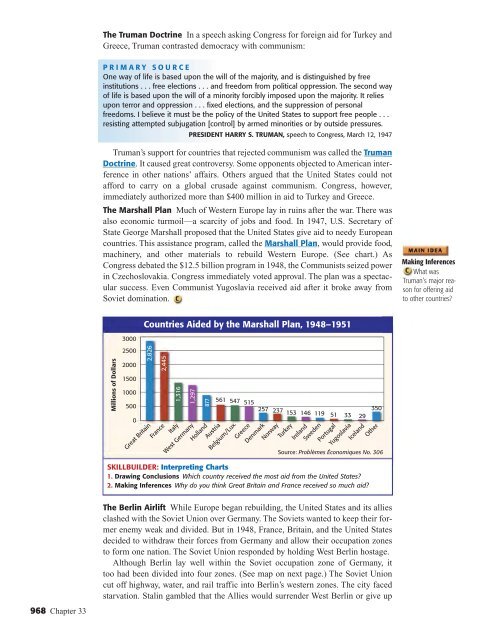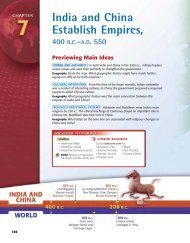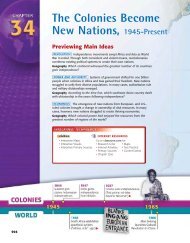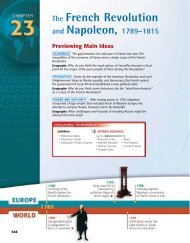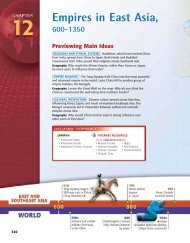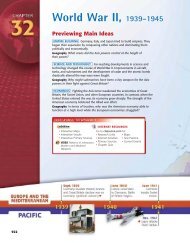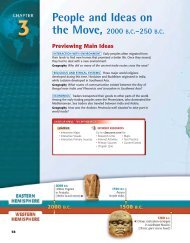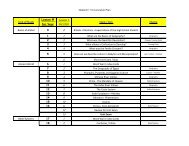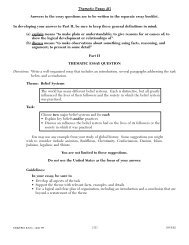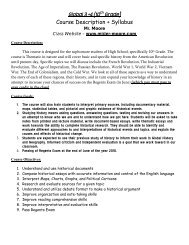Restructuring the Postwar World, - First
Restructuring the Postwar World, - First
Restructuring the Postwar World, - First
You also want an ePaper? Increase the reach of your titles
YUMPU automatically turns print PDFs into web optimized ePapers that Google loves.
968 Chapter 33<br />
The Truman Doctrine In a speech asking Congress for foreign aid for Turkey and<br />
Greece, Truman contrasted democracy with communism:<br />
PRIMARY SOURCE<br />
One way of life is based upon <strong>the</strong> will of <strong>the</strong> majority, and is distinguished by free<br />
institutions . . . free elections . . . and freedom from political oppression. The second way<br />
of life is based upon <strong>the</strong> will of a minority forcibly imposed upon <strong>the</strong> majority. It relies<br />
upon terror and oppression . . . fixed elections, and <strong>the</strong> suppression of personal<br />
freedoms. I believe it must be <strong>the</strong> policy of <strong>the</strong> United States to support free people . . .<br />
resisting attempted subjugation [control] by armed minorities or by outside pressures.<br />
PRESIDENT HARRY S. TRUMAN, speech to Congress, March 12, 1947<br />
Truman’s support for countries that rejected communism was called <strong>the</strong> Truman<br />
Doctrine. It caused great controversy. Some opponents objected to American interference<br />
in o<strong>the</strong>r nations’ affairs. O<strong>the</strong>rs argued that <strong>the</strong> United States could not<br />
afford to carry on a global crusade against communism. Congress, however,<br />
immediately authorized more than $400 million in aid to Turkey and Greece.<br />
The Marshall Plan Much of Western Europe lay in ruins after <strong>the</strong> war. There was<br />
also economic turmoil—a scarcity of jobs and food. In 1947, U.S. Secretary of<br />
State George Marshall proposed that <strong>the</strong> United States give aid to needy European<br />
countries. This assistance program, called <strong>the</strong> Marshall Plan, would provide food,<br />
machinery, and o<strong>the</strong>r materials to rebuild Western Europe. (See chart.) As<br />
Congress debated <strong>the</strong> $12.5 billion program in 1948, <strong>the</strong> Communists seized power<br />
in Czechoslovakia. Congress immediately voted approval. The plan was a spectacular<br />
success. Even Communist Yugoslavia received aid after it broke away from<br />
Soviet domination.<br />
Millions of Dollars<br />
3000<br />
2500<br />
2000<br />
1500<br />
1000<br />
500<br />
0<br />
Great Britain<br />
Countries Aided by <strong>the</strong> Marshall Plan, 1948–1951<br />
2,826<br />
2,445<br />
1,316<br />
France<br />
Italy<br />
1,297<br />
877<br />
561 547 515<br />
West Germany<br />
Holland<br />
Austria<br />
Belgium/Lux.<br />
Greece<br />
Denmark<br />
257 237 153 146 119 51 33 29<br />
Norway<br />
Turkey<br />
Ireland<br />
Sweden<br />
Portugal<br />
Yugoslavia<br />
Iceland<br />
O<strong>the</strong>r<br />
The Berlin Airlift While Europe began rebuilding, <strong>the</strong> United States and its allies<br />
clashed with <strong>the</strong> Soviet Union over Germany. The Soviets wanted to keep <strong>the</strong>ir former<br />
enemy weak and divided. But in 1948, France, Britain, and <strong>the</strong> United States<br />
decided to withdraw <strong>the</strong>ir forces from Germany and allow <strong>the</strong>ir occupation zones<br />
to form one nation. The Soviet Union responded by holding West Berlin hostage.<br />
Although Berlin lay well within <strong>the</strong> Soviet occupation zone of Germany, it<br />
too had been divided into four zones. (See map on next page.) The Soviet Union<br />
cut off highway, water, and rail traffic into Berlin’s western zones. The city faced<br />
starvation. Stalin gambled that <strong>the</strong> Allies would surrender West Berlin or give up<br />
350<br />
Source: Problèmes Économiques No. 306<br />
SKILLBUILDER: Interpreting Charts<br />
1. Drawing Conclusions Which country received <strong>the</strong> most aid from <strong>the</strong> United States?<br />
2. Making Inferences Why do you think Great Britain and France received so much aid?<br />
Making Inferences<br />
What was<br />
Truman’s major reason<br />
for offering aid<br />
to o<strong>the</strong>r countries?


